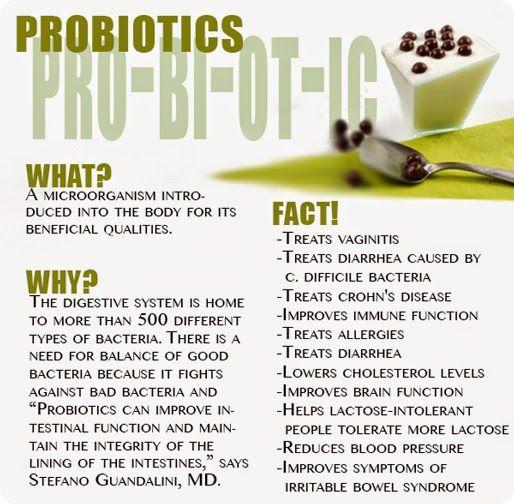
These days many of us are aware of the necessity of balance in our lives. A work life balance, a body and mind balance, eating and exercise balance. However, there is a very specific type of balancing act we should be addressing within the gut. Probiotics are organisms, such as bacteria or yeast, which are considered friendly and are believed to improve health. They can be purchased as both supplements and foods.
The concept of ingesting live bacteria or yeast may seem a little strange to some. We are often prescribed antibiotics to fight bacteria. However, our bodies are naturally teeming with such organisms, and getting the balance of friendly bacteria right can lead to a much stronger immune system. Our digestive systems house over 500 different types of bacteria, which help keep the intestines healthy and the digestive system functioning well.
Contents
Probiotics: How Do They Work?
Essentially, research suggests that digestive disorders occur when the balance of friendly bacteria in the intestines becomes upset. Usually this happens after getting an infection or taking antibiotics. Sometimes problems within the body can lead to intestinal disturbances, which probiotics can actually level out. For people with IBS, leaky gut syndrome and other digestive issues, these friendly bacteria help fight the bad bacteria which cause diarrhea. Imagine: it’s like a little war going on between good and evil bacteria!
Supplements
A variety of supplements can be taken to improve digestive health and help your body win the war against nasty bacteria which cause diarrhea and gut problems. Basically, these supplements contain examples of the healthy microflora taken from someone with a healthy gut.
Penicillum
Out of all beneficial types of fungi, Penicillum is by far the most famous! Attributed to the Scotsman Alexander Fleming, penicillin revolutionized medicines when it was discovered to have antibacterial properties, back in 1928. Penicillum is the active ingredient in penicillin, and as many people know is related to the type of mould commonly found on bread. At the time of its discovery, many diseases such as syphilis and bacterial pneumonia were rife, and could be treated quickly and effectively with penicillin. Although penicillin’s efficacy has altered due to certain resistance developed to it, it is still commonly used as an antibiotic; making it a friendly bacteria.
Lactobacillus
Lactobacillus is a family of probiotics, which are naturally found in the human digestive tract. The most recognized name of the Lactobacilli is Lactobacillus acidophilus; which is often referred to as acidophilus. Proven to help healthy digestion; acidophilus helps break down lactose and other sugars within the digestive system. Acidophilus is popular as a supplement, which makes it easily found in drugstores, health food shops and even some supermarkets. It can be bought as a capsule, which is to be taken daily. As well as other sugars, acidophilus breaks lactose down into lactic acid. This acidic environment created in the gut inhibits the multiplication of harmful bacteria. Research evidences that members of the Lactobacillus family have anti-inflammatory and anti-tumor properties, meaning they can help with a range of diseases.
Bifidobacterium
Like Lactobacillae, Bifidobacterium occur naturally in the human gut. Similarly, they help to regulate the digestive system. Bifidobacteria are commonly used in probiotic yoghurt drinks because they are help promote regularity and strengthen immunity when taken as part of a daily health regimen. Bifidobacteria also have anti-tumor qualities, and studies are investigating their use as a possible treatment for specific types of cancer.
Saccharomyces cerevisiae
Also known as brewer’s or baker’s yeast, Saccharomyces cerevisiae is nothing more than the active ingredient used to help bread rise or ferment beer. It can be bought fresh in a block, which resembles fudge, or more commonly in sachets, which are added to sugar and warm water. The etymology of the word cerevisiae comes from the Latin word for beer. Sounds similar to cerveza right? Sacchyromyces cerevisiae is sometimes used as a medical treatment for diarrhea; particularly that caused by use of antibiotics.
Streptococcus
Another widely used probiotic is Streptococcus thermophiles. It is a starter culture in the production of yogurt, mozzarella cheese and other fermented dairy products. Medicinally, it has been found to alleviate abdominal cramps, diarrhea, nausea and other gastrointestinal symptoms associated with lactose intolerance. Like lactobacillae, streptococci are a family, which include another probiotic in the Streptococcus genus: Streptococcus salivarius. Research published in The Journal of Applied Microbiology suggested including S. salivarius may improve symptoms of halitosis.

Photo Credit: Louise Atkinson from Daily Mail Online (public domain)
Outside the gut
In addition to the bacteria occurring in the human body, some bacteria are beneficial in other ways. These include bacteria used in agriculture and aquaculture to promote plant health and clean water. Fish farmers, ecologists and maintenance officers add mixtures of good bacteria to ponds. This helps to control algae, clear up toxins and restore chemical balance to the water. Fish enthusiasts can purchase beneficial bacteria solutions at their local pet store to keep aquariums clean. This in turn, ensures that pet fish are healthy.
Food sources
As we’ve said, good bacteria are microorganisms similar to those found in the human digestive tract. The health benefits are numerous from including these in your diet; including treatment of diarrhea, irritable bowel syndrome, vaginal infections, tooth decay and skin disease. Lactobacillae can be created by producing your own fermented foods such as pickles, cheese, yogurt, sauerkraut, beer and wines. Bacteria obtained by food sources mean that everything you are ingesting is 100% natural and you know its origin.
We look here at some of the most important ways to get your body’s microorganisms in order through your diet:
Yogurt
Famous as a probiotic food, live-cultured yogurt, especially if you make it yourself, can be really beneficial in helping you achieve a good balance of bacteria within the system.
Tempeh
Providing you ensure that it’s made from non GMO ingredients, tempeh is a fantastic substitute or complement to meat or tofu. Rich in probiotics and a great source of vitamin B12, this vegetarian food is delicious baked, fried or even added to salads.
Miso Soup
Made from fermented rye, soya beans, rice or barley, miso is a traditional Japanese food popular for regulating the digestive system. By adding a tablespoon of miso to hot water you can make an excellent probiotic-rich soup in next to no time. No wonder the Japanese swear by it!
Sauerkraut
One of the most famous fermented foods, sauerkraut is not only rich in healthy live cultures, but also contains excellent levels of vitamins B, A, E and C. Easy to make at home, sauerkraut is a popular digestive regulator that dates back centuries.
Kimchi
Essentially an Asian version of sauerkrat, kimchi is a spiced and sour fermented cabbage, very popular in Korea. In addition to the beneficial bacteria, Kimchi is also a great source of beta-carotene, calcium, iron and vitamins A, C, B1 and B2. One of the best probiotic foods around, it’s also relatively easy to make your own kimchi, to keep your microflora in order.
Pickles
Incredibly, even the most common green pickle, like the gherkins in your burger is actually an excellent food source of probiotics. Of course, the less commercialized the better; pickles have incredible microbial value, and are easy to make at home.
Mircoalgae
These wonderful nutritious additives aren’t exactly foods. However they make a great addition to smoothies and salads and really promote a healthy digestive tract. Microaglae refers to superfoods from the sea such as spirulina, chorella, and blue-green algae, and other seaweeds. The nutrient properties are out of this world!

